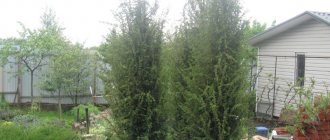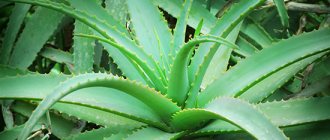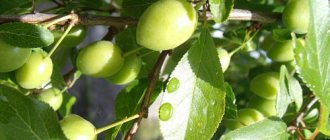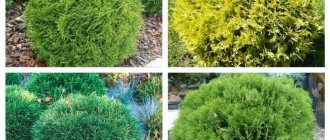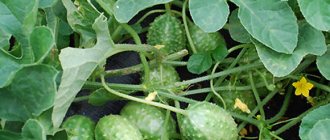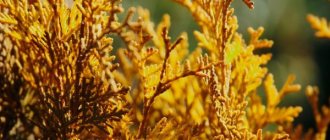Thuja occidentalis Teddy is an unusual spherical variety of conifer that is new. Despite this, he has already managed to gain wide popularity. This species was obtained on the basis of the western thuja and is also one of the representatives of the Cypress family. It is unpretentious to growing conditions and does not suffer from polluted air, so it can be used for landscaping parks, squares, and private plots.
Thuja Teddy does not require corrective pruning
Description of Western Thuja Teddy
The authors of the variety named the dwarf bush with a cushion-shaped crown “Bear Cub” because of its small size and thick, soft needles. The spherical thuja Teddy retains its miniature size for a long time:
- grows by only 25-35 mm per year;
- 3-year-old seedlings, which are sold in nurseries in 3-liter containers, miniature - 10-15 cm in height and width;
- after 10 years, the height of the bush reaches only 30-40 cm, diameter 30-35 cm;
- after 17-20 years of development, it gains the declared size of an adult plant - 0.5 m.
The root system of the dwarf Teddy variety is located near the soil surface, densely branched, and requires loose and constantly slightly moist soil. Thin but densely growing shoots themselves form a rounded, dense crown of the western thuja, usually several centimeters more in width than in height. With age, after 23-25 years, the branches fall apart a little. The soft-needle needles are thick, dark green, and not prickly; thanks to them, the shrub variety gives the impression of a plush ball from a distance. With cold weather, the needles become brownish, but in the spring they turn green again.
The shade-tolerant Teddy variety requires only 4-5 hours of sun exposure and develops well in semi-shaded areas. In the southern regions, western thuja bushes are grown only in areas with sufficient shading or with constant drip irrigation. Needles do not tolerate dry air well. The plant tolerates several days without watering, but the superficial location of the roots of the species dictates its own conditions for caring for the moisture-loving evergreen bush. Thuja Teddy tolerates temperatures down to -31-32 °C; young plants are covered for the winter. The shoots of the variety initially form a rounded crown and are amenable to topiary cutting.
Description of the variety
Teddy is a new variety. Its name is translated from English as “bear cub”. The plant lives up to its touching name in many ways. It is a low-growing cushion-shaped shrub with thin, closely spaced shoots. The culture owes its magnificent appearance to its dense crown formed by thick, needle-like, fluffy, soft-to-the-touch needles of a dark green color, often with a bluish tint. In winter, it takes on a brownish or bronze tint. Adult specimens can boast of having shoots with scaly needles.
The shrub is characterized by extremely slow growth. Every year its dimensions increase by only a couple of centimeters. Thus, at the age of 10 years, the thuja reaches a height of no more than 0.4 meters. The width of the conifer is exactly the same. The shape of the bush is spherical.
This variety is sensitive to soil compaction because it has shallow, branched roots. But it is shade-tolerant and has good winter hardiness. Ephedra is rarely damaged by insects and fungal diseases, but is vulnerable to sunburn in early spring.
The use of Thuja Teddy in landscape design
The dwarf variety of western thuja with a dense spherical crown looks great as an evergreen soloist in any flower bed or lawn. The view near the garden or driveway is even more interesting if several specimens of the Teddy variety are used for borders. This is also an ideal option for container culture, provided that the containers with thuja are brought into a frost-free room for the winter or are well wrapped. Judging by various photos, thuja Teddy is in demand in landscape design and makes an original impression. The variety is popular for plantings in Japanese gardens, rock gardens, and rockeries. Thuja Teddy is appropriate in miniature green compositions on terraces, loggias, and roofs of residential buildings. The dwarf thuja western bush is placed in the foreground in large flower beds and mixborders.
Important! A distance of 40-50 cm is maintained between the thujas in the row.
Description and types of plants
evergreen
There are several types of thuja:
- Western.
- Korean.
- Japanese.
- Gigantic.
- Sichuan.
Some species have a tree-like appearance, up to two meters high, and there are very miniature representatives. All thujas belong to the Cypress family. The globular thuja is found naturally in North America and very limited areas of East Asia. Only thuja occidentalis grows on the territory of Russia.
The stem of the plant is soft at first, and after some time it becomes thick and tough. The needles are quite soft. The crown can have a color from light green to dark green, depending on the specific variety.
The needles grow on the branches for three years, and then fall off and new needles grow in their place. A young plant may produce fruits. They have the shape of a box in which flat, oblong seeds are formed. The seeds are green at first, but as they ripen they turn brown.
Thuja varieties
Thuja occidentalis Mister bowling ball. This bush looks very neat, it doesn’t even need to be cut. Although pruning can be done in late spring or summer, the branches will recover quickly after pruning.
The foliage is bright and does not fade even in sunny areas and in winter. Grows well in fertile, moist soils.
Miriam. The shrub has dwarf dimensions and does not exceed a height of 80 centimeters. In winter, the crown acquires a bronze tint; by spring it turns yellow. In summer, the foliage is bright green with a yellowish tint. The crown is dense and tolerates cutting well.
Thuja globose Danica. Thuja Danica is used most often in landscape design; it does not require difficult conditions of maintenance and care. This variety has soft green needles and thin needles. The branches grow vertically. The height of an adult plant reaches 0.6−0.8 meters. The diameter of thuja Danika is about 1 meter. Thuja Danica grows quite slowly, per year the height of the plant increases by 5-6 centimeters, and the diameter by 3-4 centimeters.
Thuja occidentalis maria wn. This variety is not very common in gardens, as it has increased requirements for soil nutrition. It has a medium crown size, which allows it to be used as decorative fences. This variety has small branches that fit tightly to the main stem. The crown has a rich green color.
Features of reproduction
According to reviews, the Teddy variety is easily propagated using cuttings - through rooting or by grafting. Select straight shoots without signs of disease from the middle of the bush. Gardeners share the secret of how to pick a viable cutting - you need to firmly grasp the branch and pull it strongly towards you. Usually, after such manipulation, the shoot is torn off with a piece of bark from the trunk. This old wood, rich in special substances, will help the cutting take root in a new place.
For successful root formation, the cuttings are treated with a growth stimulator according to the instructions and planted in a loose substrate of sand and garden soil in a container or in the shade on an area. A film canopy is installed on top, which is opened daily for ventilation, and the cuttings are sprayed with water. The greenhouse is removed after rooting. In late autumn, the seedlings are mulched with peat and covered with spruce branches or mats made of natural material.
Planting and caring for Western Thuja Teddy
Judging by the photo, this dwarf variety is popular in garden arrangements. Planting thuja western Teddy and caring for young shrubs require the gardener's attention during the first years. Adult plants are not so capricious.
Recommended timing
Proven varietal seedling material is sold in nurseries, grown in containers. Such plants are planted during any period of the warm season. It is better to purchase bushes with an open root system close to the site and plant them within one or two days in early spring or early autumn. Autumn planting requires that the seedlings have enough time before frost to take root.
Site selection and soil preparation
To plant the western Teddy thuja variety, choose a sunny or semi-shaded place in the middle zone, protected from drafts and sharp gusts of wind. The bush is not suitable for low-lying areas where water collects after rain or melting snow. The thuja Teddy variety will also feel uncomfortable in the sun, especially in areas with high summer temperatures - due to dry air and compacted soil without watering. The crown will react to unsuitable conditions:
- the shoots will develop unevenly and form an untidy and sparse silhouette;
- the needles burn out from the sunny side.
The Teddy variety prefers loose, moist, fertile soil with neutral or weak acidity. Light loams and clayey sandy loams are suitable for thuja occidentalis. You should take care of the substrate in the planting hole in advance:
- 1 part sand;
- 1 part peat;
- 1 part leaf compost;
- 2 parts of garden soil;
- complex fertilizer or top dressing for conifers at the rate of 5-7 g of the drug per 1 kg of soil mixture.
Advice! The fertilizer rate is increased to 8-10 g if there is no compost in the substrate.
Landing algorithm
For a dwarf western thuja bush, a spacious planting hole is prepared so that the surface roots can spread freely: 60x60x60 cm. On heavy soils, drainage is laid down to 15-20 cm and the thuja is planted:
- the substrate is placed on the drainage layer;
- place the Teddy seedling, making sure that the root collar is at the level of the garden soil;
- sprinkle with an earthen lump and compact the substrate;
- water with 9-11 liters of water;
- mulch around the perimeter of the hole.
Landing
Proper planting of the thuja will ensure its further growth and health.
1. The first thing you need to do is choose the right place. Of course, this is an unpretentious plant that will grow anywhere, but will it please you with its appearance? Thuja prefers partial shade and minimal wind. In areas with little sunshine, the plant can be planted in the sunniest spot possible. In the southern regions it is better to plant it in the shade. The bush does not like absolute shade: this will be evidenced by thin branches with small needles and the thinness of the bush.
Western Thuja Danica grows best in sheltered areas
2. The second important point when landing is time. Thuja needs to be planted in March-April. In May, it begins to actively grow, and during this period it is better not to touch it. For planting, prepare a hole with sand, peat and soil. Within two weeks, the pit needs to be moistened and fertilizer added.
The spherical thuja is ideal for decorating the path leading to the house
Advice! An adult plant 5-7 years old can be planted in a permanent place. Before planting, the bush is taken out of the pot and the roots are cut so that it grows better and grows into the ground. Add a root former to a bucket of water and pour it into the hole.
After this, the plant can be planted in the hole. You need to sprinkle a little soil on top. The spherical thuja grows slowly, and therefore it will be difficult for it if branches immediately come out of the ground.
Globular thuja is often used as an addition to the design of a garden or flower bed.
Within a month, the seedling must be watered with a whole bucket of water. If the summer is sunny and hot, it is better to cover the tree from direct rays. This applies to the entire summer season in the first year after planting.
Important! If you plant several shrubs side by side, you must maintain a distance of at least 50 cm between them.
Compact neat flower bed with spherical thuja
Tips on how to plant thuja correctly can be found here:
Rules for growing and care
They admire in their garden such harmonious Teddy thujas as in the photo, planting and caring for which are carried out according to the recommendations of specialists.
Watering schedule
A lot of moisture evaporates through thuja needles, so the bushes need regular and abundant watering. Ideally, the soil near Teddy's thuja should always be loose and moderately moist. A bucket of water will be used per bush once a week. In hot weather, water more often and sprinkle in the evening. In the morning, lightly loosen the tree trunk circle or mulch it.
Comment! After spring feeding, thuja is watered with 12-15 liters of water 2 times a week, if there is no precipitation.
Top dressing
A beautiful bush is created by regular fertilizers, which for the Teddy variety is carried out 2 times a year:
- in early spring, thuja is fed with a complex preparation - up to 60 g per root;
- in September, before moisture recharging, potassium-phosphorus fertilizers are given.
Trimming
The Teddy variety is not trimmed to form a crown, although the thuja occidentalis easily tolerates the procedure. Only specialists do topiary haircuts. Every year in autumn and spring, inspect the bush and cut off dry and damaged branches. If any shoot gets out of the spherical shape, it is corrected. When cutting thuja, only 3rd part of the growth is removed.
Preparing for winter
Western thuja seedlings are covered for the winter during the first three seasons. Then adult plants tolerate the winters of the middle zone painlessly. The shelter is prepared from natural materials, dense agrofibre, burlap. In late autumn, after feeding and watering, the tree trunk circle is mulched with a layer of bark or peat up to 12 cm. All branches of young plants of the Teddy variety are tied up so that they do not break off under the weight of snow. When the bush begins to create a round crown, the branches are not tied.
If there is heavy snowfall in the area, it is worth purchasing a round or pyramidal frame for the western Teddy thuja, according to the photo and description, which will protect the crown from falling apart in winter. Spruce branches or branches are placed on top of the structure after cutting the bushes. In February and March, Teddy's thujas are covered with mesh or agrofibre so that the needles do not fade in the sun.
Landing
A beautiful tree only in prepared soil
Thuja is an unpretentious variety and grows quietly on any type of soil.
However, in order to get a beautiful and well-groomed plant, it is better to choose light and well-drained soil for planting.
Selection of seedlings
At the garden market, Teddy seedlings are presented with open and closed root systems. In the first case, the price is slightly lower.
- Bare-root specimens are planted in early spring or autumn.
- Specimens in containers (with closed roots) are selected based on the condition of the bark and shoots; they can be replanted from April to October.
Sometimes unscrupulous sellers place seedlings intended for sale bare-rooted in containers and thus offer low-quality planting material.
Deception is determined by an elongated or crookedly formed crown, the absence of roots and the crumbling of the earthen clod.
Preparing the site
Description of a good place for planting seedlings:
- good lighting, but without direct sunlight, so that the needles do not burn out;
- there is wind protection;
- a plot with a slight slope or with an elevation, because the crop does not tolerate excess moisture.
Landing technology
In order not to harm the root system when transplanting from a container, it is recommended to water the plant generously the day before the procedure. This way it will be easy to remove the thuja from the container along with the soil.
- Preparing the pit. To do this, you need to dig a recess that will exceed the volume of the container several times. Broken brick or expanded clay is laid at the bottom in a layer at least 20 cm wide. This will provide drainage for the plant and protection from the heaviness of the soil.
- Adding fertilizer to the hole. It is filled almost to the edge with a mixture consisting of 3 components: peat, turf soil and sand (taken in equal proportions). If the soil composition is poor, it is recommended to use complex mineral fertilizers. Thujas also respond well to organic matter (compost, humus or wood ash). The pit with the earth mixture and fertilizers is trampled down and watered abundantly.
- Landing. The seedling must be positioned so that the root collar is flush with the ground surface. If necessary, add soil.
- Compacting the soil and watering. Mulching is recommended at this stage.
Seedlings are placed at a distance of at least 40 cm
While the seedlings are taking root, it is especially important to monitor soil moisture
Caring for the Teddy shrub is quite standard for the crop and consists of timely watering, annual feeding, treatment of the root zone and pruning of dried branches.
Watering
Teddy needs to be watered once a week. It takes 8-10 liters per bush.
In dry weather conditions, watering is increased up to 2-3 times, focusing on the degree of drying of the soil.
The plant responds well to spraying the crown with water. The procedure is recommended to be carried out in the morning or evening 2-3 times a week.
Feeding
It is enough to feed Teddy once a year. Mineral complexes for conifers are excellent for this. Fertilizers are applied in early spring.
You can also use nitroammophoska (a product based on nitrogen, phosphorus and potassium), but you will need to add additional fertilizing in the fall.
Mulching and loosening the soil
Mulching of thuja involves covering the root zone with peat, sawdust, dry grass or other material. This agricultural technique is used to preserve moisture, avoid the appearance of weeds and parasites, and provide additional nutrition to the plant.
If you do not carry out the procedure, then the root zone of the bush must be loosened after each watering.
The close location of the roots to the surface should be taken into account and manipulations should be carried out very carefully
Haircut and trimming
Teddy independently forms a spherical crown as it grows, so there is no need to specifically trim the plant.
However, in early spring it is recommended to carry out sanitary pruning, during which dry and broken branches are removed.
Preparing for winter
Mature bushes tolerate temperature drops down to -30°; there is no need to remove them for winter.
But for young plants that have not reached 3 years of age, it is better to wrap them in burlap or other material, having first removed the mulch, if any.
For shrubs with an unformed crown, it is recommended to tie the stems before the onset of cold weather.
Pests and diseases
Western thujas get sick from fungal infections. For prevention, Teddy bushes are sprayed with Bordeaux mixture or copper sulfate in early spring, treating the entire garden. In case of disease, fungicides are used:
- Maksim;
- Horus;
- Quadris and others.
Teddy's soft needles can suffer from insects that suck the juice from greens: aphids, false scale insects, as well as from spider mites. Insecticides are used against pests:
- Confidor;
- Aktara;
- Angio.
And against ticks - acaricides.
